The Role and Importance of Nursing Regulation in Australia: A Report
VerifiedAdded on 2023/01/23
|7
|1866
|70
Report
AI Summary
This report delves into the multifaceted landscape of nursing regulation in Australia. It begins with an introduction to the nursing profession and the pivotal role of the Nursing and Midwifery Board of Australia (NMBA). The report explores the evolution of nursing regulations, highlighting the shift from hospital-based training to the current national registration scheme. It emphasizes the significance of regulation in ensuring competent and safe practice, protecting the public from unqualified practitioners, and maintaining high standards of care. The report outlines the key components of the NMBA's quality guidelines, including scope of practice, codes of conduct, and standards of practice. It also examines the ethical responsibilities of nurses, the importance of registration for both practicing nurses and student nurses, and the consequences of non-compliance. The report concludes by underscoring the importance of accountability, professionalism, and the ethical duty of care within the nursing profession, as well as the necessity of registration for the safety of both patients and nursing students. The report references various sources to support the information provided.
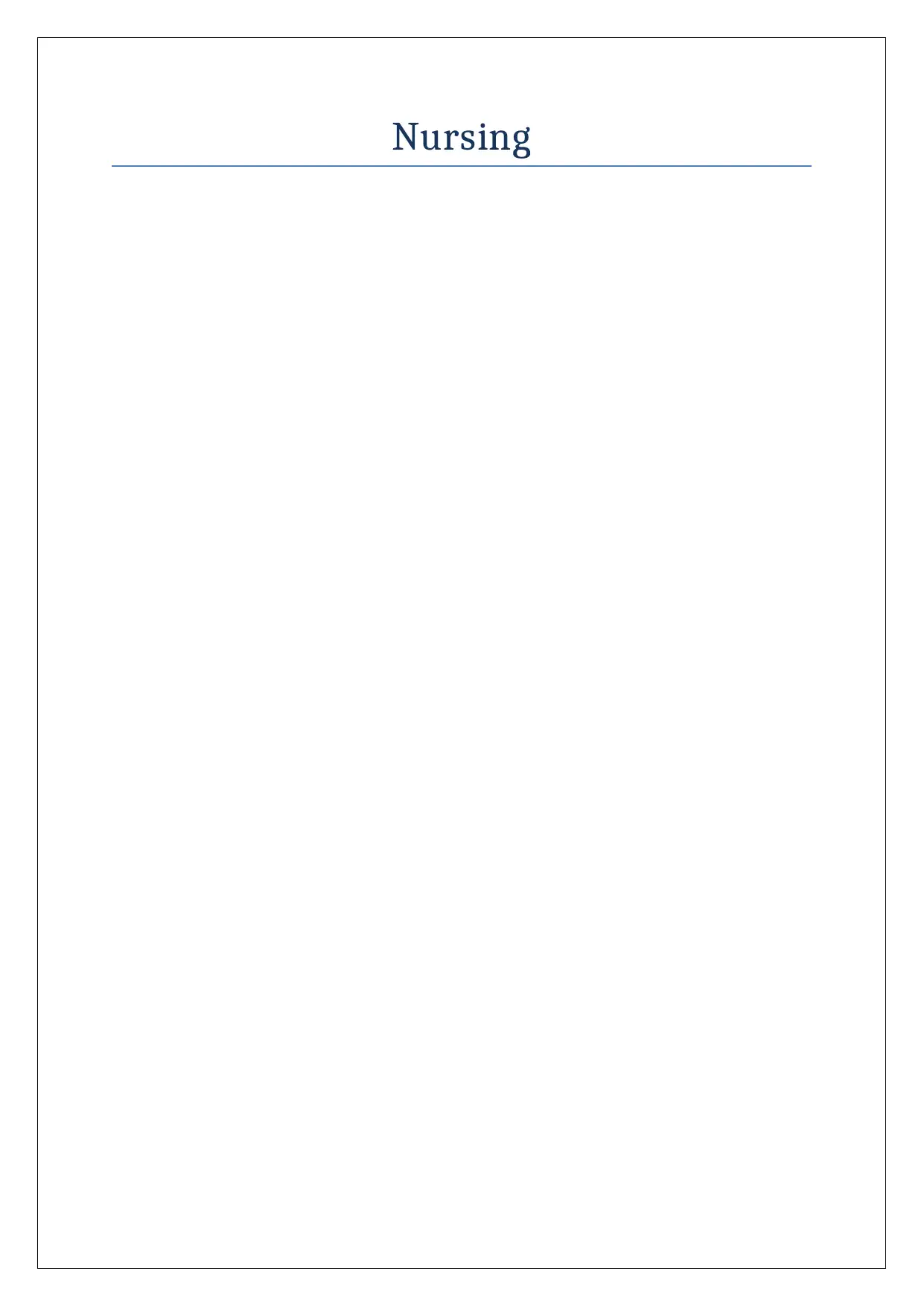
Nursing
Paraphrase This Document
Need a fresh take? Get an instant paraphrase of this document with our AI Paraphraser
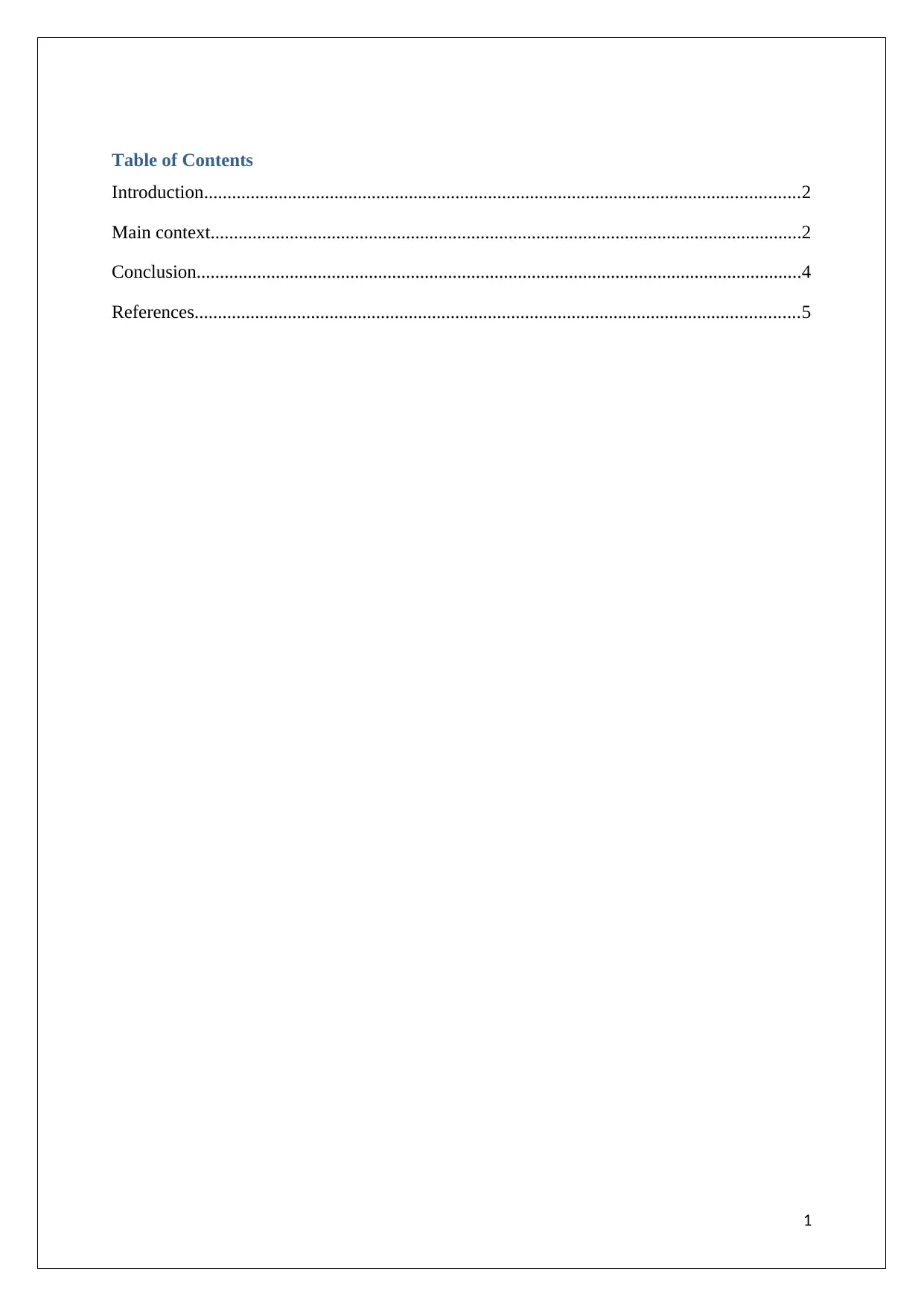
Table of Contents
Introduction................................................................................................................................2
Main context...............................................................................................................................2
Conclusion..................................................................................................................................4
References..................................................................................................................................5
1
Introduction................................................................................................................................2
Main context...............................................................................................................................2
Conclusion..................................................................................................................................4
References..................................................................................................................................5
1
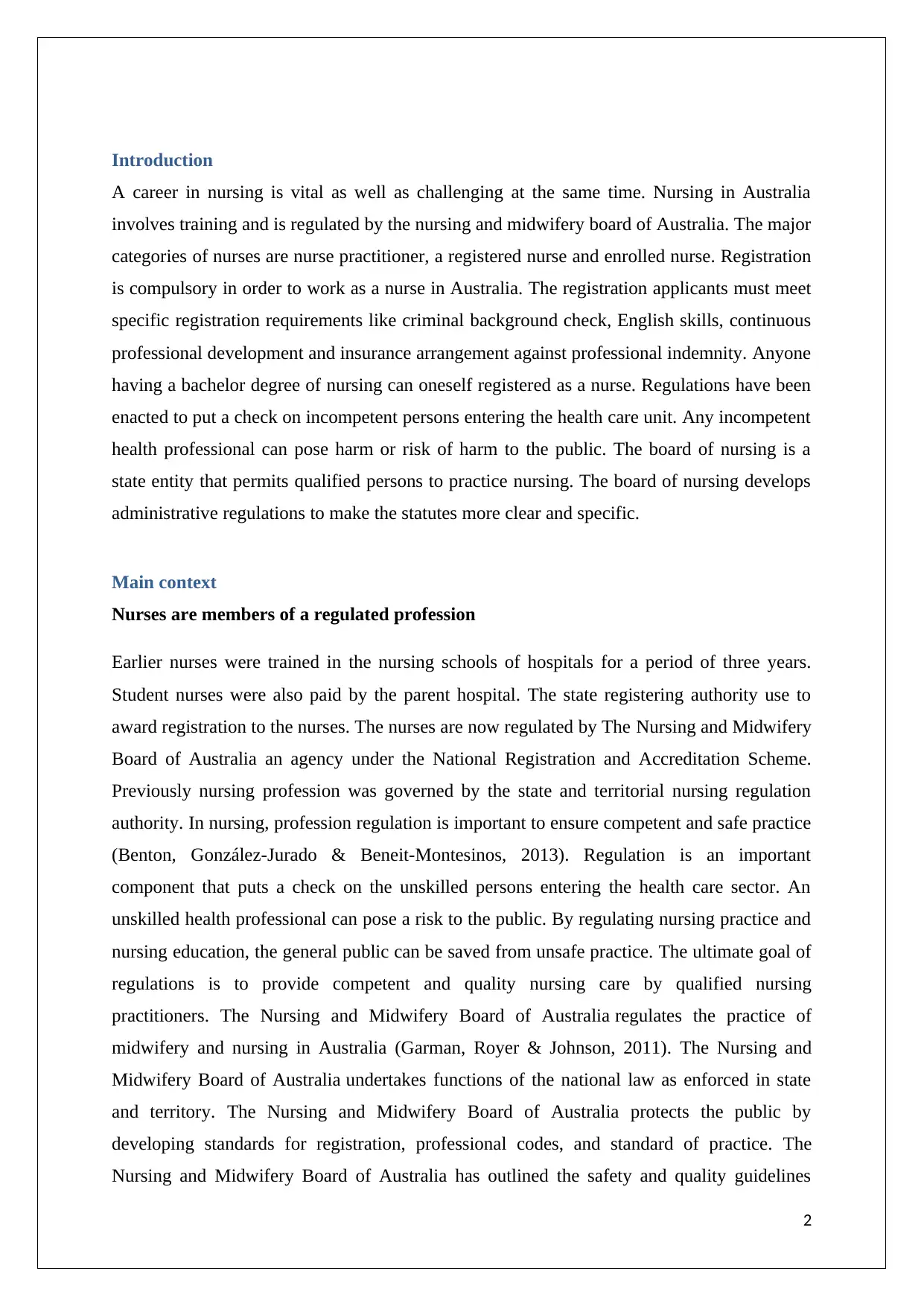
Introduction
A career in nursing is vital as well as challenging at the same time. Nursing in Australia
involves training and is regulated by the nursing and midwifery board of Australia. The major
categories of nurses are nurse practitioner, a registered nurse and enrolled nurse. Registration
is compulsory in order to work as a nurse in Australia. The registration applicants must meet
specific registration requirements like criminal background check, English skills, continuous
professional development and insurance arrangement against professional indemnity. Anyone
having a bachelor degree of nursing can oneself registered as a nurse. Regulations have been
enacted to put a check on incompetent persons entering the health care unit. Any incompetent
health professional can pose harm or risk of harm to the public. The board of nursing is a
state entity that permits qualified persons to practice nursing. The board of nursing develops
administrative regulations to make the statutes more clear and specific.
Main context
Nurses are members of a regulated profession
Earlier nurses were trained in the nursing schools of hospitals for a period of three years.
Student nurses were also paid by the parent hospital. The state registering authority use to
award registration to the nurses. The nurses are now regulated by The Nursing and Midwifery
Board of Australia an agency under the National Registration and Accreditation Scheme.
Previously nursing profession was governed by the state and territorial nursing regulation
authority. In nursing, profession regulation is important to ensure competent and safe practice
(Benton, González-Jurado & Beneit-Montesinos, 2013). Regulation is an important
component that puts a check on the unskilled persons entering the health care sector. An
unskilled health professional can pose a risk to the public. By regulating nursing practice and
nursing education, the general public can be saved from unsafe practice. The ultimate goal of
regulations is to provide competent and quality nursing care by qualified nursing
practitioners. The Nursing and Midwifery Board of Australia regulates the practice of
midwifery and nursing in Australia (Garman, Royer & Johnson, 2011). The Nursing and
Midwifery Board of Australia undertakes functions of the national law as enforced in state
and territory. The Nursing and Midwifery Board of Australia protects the public by
developing standards for registration, professional codes, and standard of practice. The
Nursing and Midwifery Board of Australia has outlined the safety and quality guidelines
2
A career in nursing is vital as well as challenging at the same time. Nursing in Australia
involves training and is regulated by the nursing and midwifery board of Australia. The major
categories of nurses are nurse practitioner, a registered nurse and enrolled nurse. Registration
is compulsory in order to work as a nurse in Australia. The registration applicants must meet
specific registration requirements like criminal background check, English skills, continuous
professional development and insurance arrangement against professional indemnity. Anyone
having a bachelor degree of nursing can oneself registered as a nurse. Regulations have been
enacted to put a check on incompetent persons entering the health care unit. Any incompetent
health professional can pose harm or risk of harm to the public. The board of nursing is a
state entity that permits qualified persons to practice nursing. The board of nursing develops
administrative regulations to make the statutes more clear and specific.
Main context
Nurses are members of a regulated profession
Earlier nurses were trained in the nursing schools of hospitals for a period of three years.
Student nurses were also paid by the parent hospital. The state registering authority use to
award registration to the nurses. The nurses are now regulated by The Nursing and Midwifery
Board of Australia an agency under the National Registration and Accreditation Scheme.
Previously nursing profession was governed by the state and territorial nursing regulation
authority. In nursing, profession regulation is important to ensure competent and safe practice
(Benton, González-Jurado & Beneit-Montesinos, 2013). Regulation is an important
component that puts a check on the unskilled persons entering the health care sector. An
unskilled health professional can pose a risk to the public. By regulating nursing practice and
nursing education, the general public can be saved from unsafe practice. The ultimate goal of
regulations is to provide competent and quality nursing care by qualified nursing
practitioners. The Nursing and Midwifery Board of Australia regulates the practice of
midwifery and nursing in Australia (Garman, Royer & Johnson, 2011). The Nursing and
Midwifery Board of Australia undertakes functions of the national law as enforced in state
and territory. The Nursing and Midwifery Board of Australia protects the public by
developing standards for registration, professional codes, and standard of practice. The
Nursing and Midwifery Board of Australia has outlined the safety and quality guidelines
2
⊘ This is a preview!⊘
Do you want full access?
Subscribe today to unlock all pages.

Trusted by 1+ million students worldwide
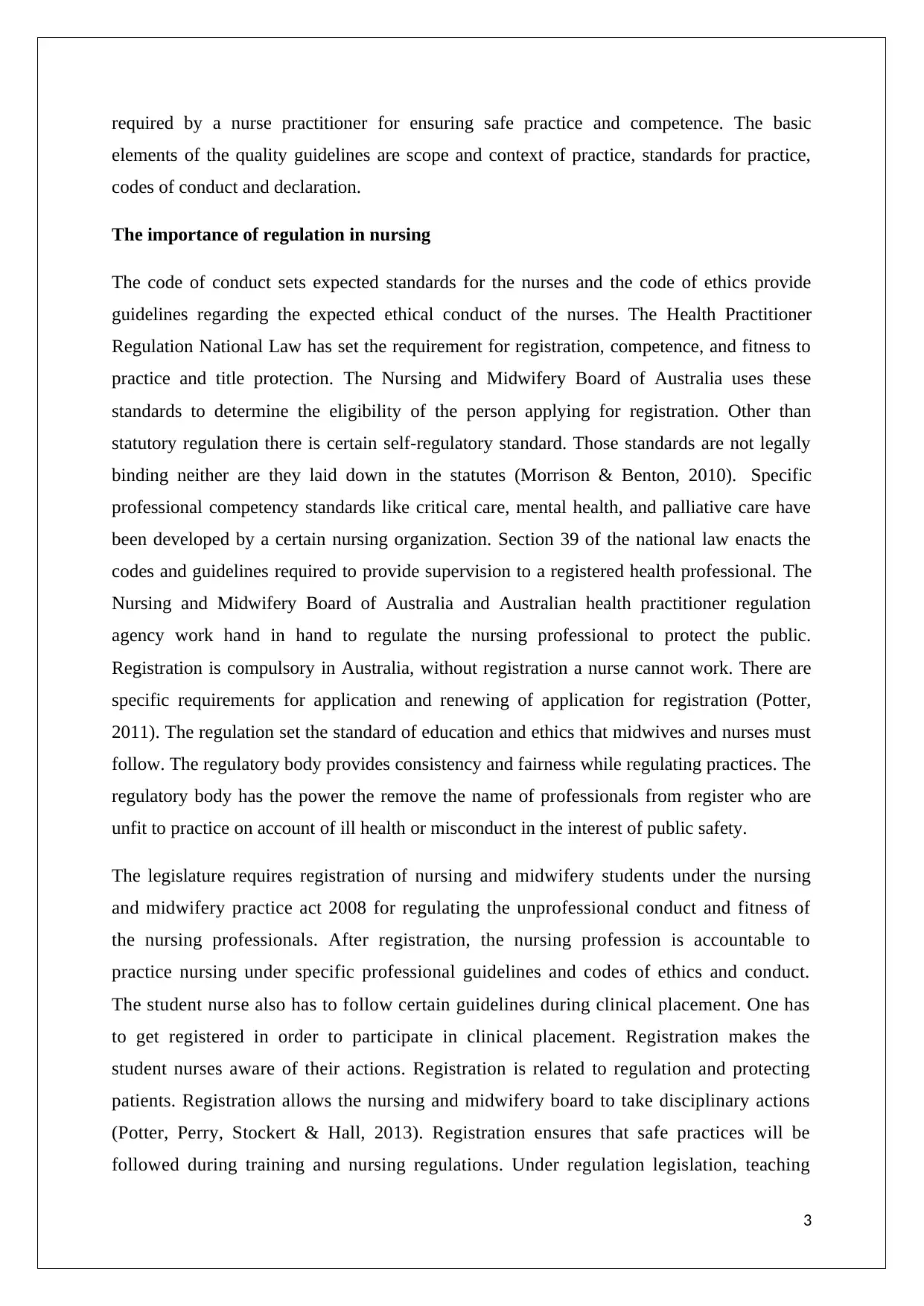
required by a nurse practitioner for ensuring safe practice and competence. The basic
elements of the quality guidelines are scope and context of practice, standards for practice,
codes of conduct and declaration.
The importance of regulation in nursing
The code of conduct sets expected standards for the nurses and the code of ethics provide
guidelines regarding the expected ethical conduct of the nurses. The Health Practitioner
Regulation National Law has set the requirement for registration, competence, and fitness to
practice and title protection. The Nursing and Midwifery Board of Australia uses these
standards to determine the eligibility of the person applying for registration. Other than
statutory regulation there is certain self-regulatory standard. Those standards are not legally
binding neither are they laid down in the statutes (Morrison & Benton, 2010). Specific
professional competency standards like critical care, mental health, and palliative care have
been developed by a certain nursing organization. Section 39 of the national law enacts the
codes and guidelines required to provide supervision to a registered health professional. The
Nursing and Midwifery Board of Australia and Australian health practitioner regulation
agency work hand in hand to regulate the nursing professional to protect the public.
Registration is compulsory in Australia, without registration a nurse cannot work. There are
specific requirements for application and renewing of application for registration (Potter,
2011). The regulation set the standard of education and ethics that midwives and nurses must
follow. The regulatory body provides consistency and fairness while regulating practices. The
regulatory body has the power the remove the name of professionals from register who are
unfit to practice on account of ill health or misconduct in the interest of public safety.
The legislature requires registration of nursing and midwifery students under the nursing
and midwifery practice act 2008 for regulating the unprofessional conduct and fitness of
the nursing professionals. After registration, the nursing profession is accountable to
practice nursing under specific professional guidelines and codes of ethics and conduct.
The student nurse also has to follow certain guidelines during clinical placement. One has
to get registered in order to participate in clinical placement. Registration makes the
student nurses aware of their actions. Registration is related to regulation and protecting
patients. Registration allows the nursing and midwifery board to take disciplinary actions
(Potter, Perry, Stockert & Hall, 2013). Registration ensures that safe practices will be
followed during training and nursing regulations. Under regulation legislation, teaching
3
elements of the quality guidelines are scope and context of practice, standards for practice,
codes of conduct and declaration.
The importance of regulation in nursing
The code of conduct sets expected standards for the nurses and the code of ethics provide
guidelines regarding the expected ethical conduct of the nurses. The Health Practitioner
Regulation National Law has set the requirement for registration, competence, and fitness to
practice and title protection. The Nursing and Midwifery Board of Australia uses these
standards to determine the eligibility of the person applying for registration. Other than
statutory regulation there is certain self-regulatory standard. Those standards are not legally
binding neither are they laid down in the statutes (Morrison & Benton, 2010). Specific
professional competency standards like critical care, mental health, and palliative care have
been developed by a certain nursing organization. Section 39 of the national law enacts the
codes and guidelines required to provide supervision to a registered health professional. The
Nursing and Midwifery Board of Australia and Australian health practitioner regulation
agency work hand in hand to regulate the nursing professional to protect the public.
Registration is compulsory in Australia, without registration a nurse cannot work. There are
specific requirements for application and renewing of application for registration (Potter,
2011). The regulation set the standard of education and ethics that midwives and nurses must
follow. The regulatory body provides consistency and fairness while regulating practices. The
regulatory body has the power the remove the name of professionals from register who are
unfit to practice on account of ill health or misconduct in the interest of public safety.
The legislature requires registration of nursing and midwifery students under the nursing
and midwifery practice act 2008 for regulating the unprofessional conduct and fitness of
the nursing professionals. After registration, the nursing profession is accountable to
practice nursing under specific professional guidelines and codes of ethics and conduct.
The student nurse also has to follow certain guidelines during clinical placement. One has
to get registered in order to participate in clinical placement. Registration makes the
student nurses aware of their actions. Registration is related to regulation and protecting
patients. Registration allows the nursing and midwifery board to take disciplinary actions
(Potter, Perry, Stockert & Hall, 2013). Registration ensures that safe practices will be
followed during training and nursing regulations. Under regulation legislation, teaching
3
Paraphrase This Document
Need a fresh take? Get an instant paraphrase of this document with our AI Paraphraser
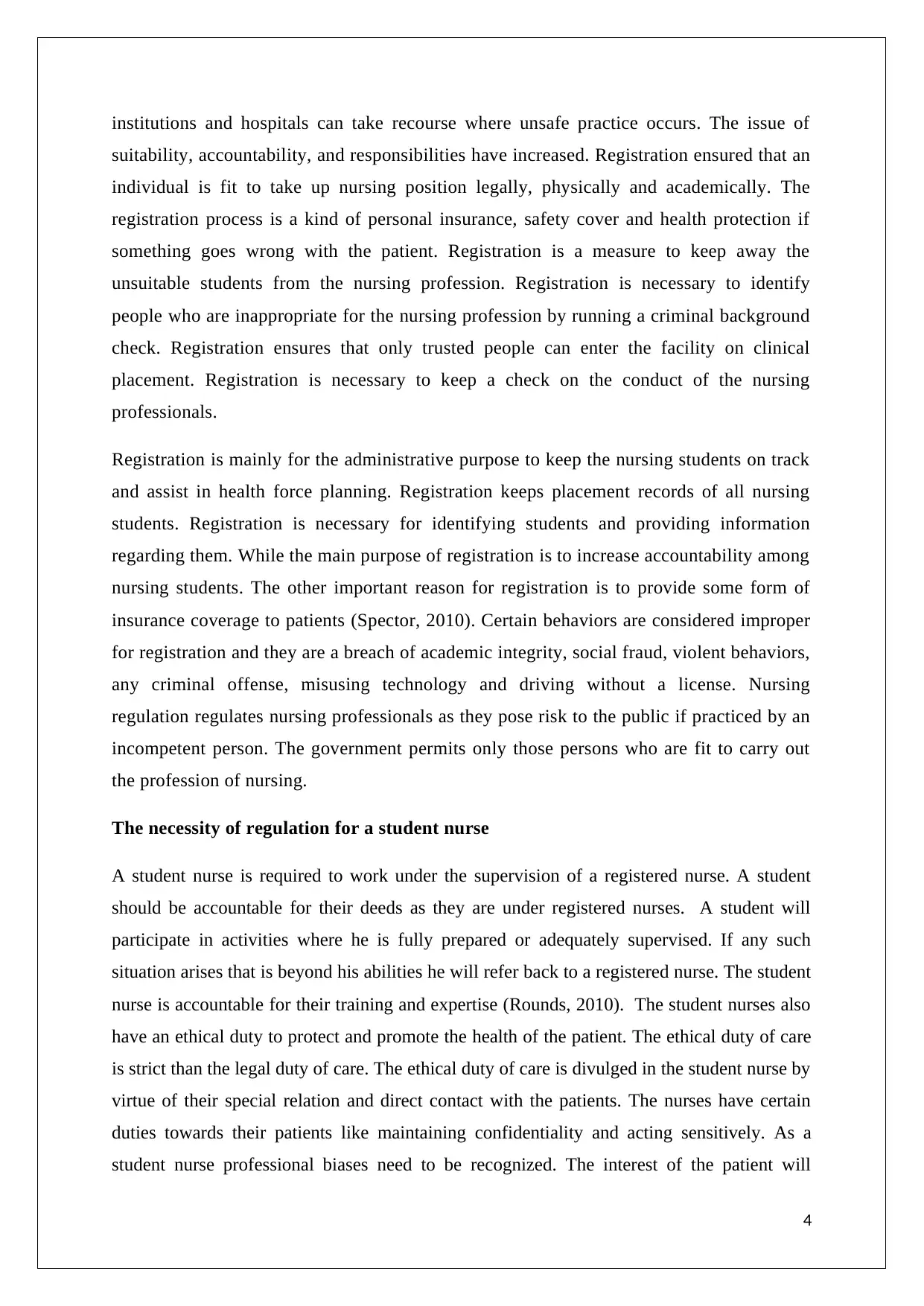
institutions and hospitals can take recourse where unsafe practice occurs. The issue of
suitability, accountability, and responsibilities have increased. Registration ensured that an
individual is fit to take up nursing position legally, physically and academically. The
registration process is a kind of personal insurance, safety cover and health protection if
something goes wrong with the patient. Registration is a measure to keep away the
unsuitable students from the nursing profession. Registration is necessary to identify
people who are inappropriate for the nursing profession by running a criminal background
check. Registration ensures that only trusted people can enter the facility on clinical
placement. Registration is necessary to keep a check on the conduct of the nursing
professionals.
Registration is mainly for the administrative purpose to keep the nursing students on track
and assist in health force planning. Registration keeps placement records of all nursing
students. Registration is necessary for identifying students and providing information
regarding them. While the main purpose of registration is to increase accountability among
nursing students. The other important reason for registration is to provide some form of
insurance coverage to patients (Spector, 2010). Certain behaviors are considered improper
for registration and they are a breach of academic integrity, social fraud, violent behaviors,
any criminal offense, misusing technology and driving without a license. Nursing
regulation regulates nursing professionals as they pose risk to the public if practiced by an
incompetent person. The government permits only those persons who are fit to carry out
the profession of nursing.
The necessity of regulation for a student nurse
A student nurse is required to work under the supervision of a registered nurse. A student
should be accountable for their deeds as they are under registered nurses. A student will
participate in activities where he is fully prepared or adequately supervised. If any such
situation arises that is beyond his abilities he will refer back to a registered nurse. The student
nurse is accountable for their training and expertise (Rounds, 2010). The student nurses also
have an ethical duty to protect and promote the health of the patient. The ethical duty of care
is strict than the legal duty of care. The ethical duty of care is divulged in the student nurse by
virtue of their special relation and direct contact with the patients. The nurses have certain
duties towards their patients like maintaining confidentiality and acting sensitively. As a
student nurse professional biases need to be recognized. The interest of the patient will
4
suitability, accountability, and responsibilities have increased. Registration ensured that an
individual is fit to take up nursing position legally, physically and academically. The
registration process is a kind of personal insurance, safety cover and health protection if
something goes wrong with the patient. Registration is a measure to keep away the
unsuitable students from the nursing profession. Registration is necessary to identify
people who are inappropriate for the nursing profession by running a criminal background
check. Registration ensures that only trusted people can enter the facility on clinical
placement. Registration is necessary to keep a check on the conduct of the nursing
professionals.
Registration is mainly for the administrative purpose to keep the nursing students on track
and assist in health force planning. Registration keeps placement records of all nursing
students. Registration is necessary for identifying students and providing information
regarding them. While the main purpose of registration is to increase accountability among
nursing students. The other important reason for registration is to provide some form of
insurance coverage to patients (Spector, 2010). Certain behaviors are considered improper
for registration and they are a breach of academic integrity, social fraud, violent behaviors,
any criminal offense, misusing technology and driving without a license. Nursing
regulation regulates nursing professionals as they pose risk to the public if practiced by an
incompetent person. The government permits only those persons who are fit to carry out
the profession of nursing.
The necessity of regulation for a student nurse
A student nurse is required to work under the supervision of a registered nurse. A student
should be accountable for their deeds as they are under registered nurses. A student will
participate in activities where he is fully prepared or adequately supervised. If any such
situation arises that is beyond his abilities he will refer back to a registered nurse. The student
nurse is accountable for their training and expertise (Rounds, 2010). The student nurses also
have an ethical duty to protect and promote the health of the patient. The ethical duty of care
is strict than the legal duty of care. The ethical duty of care is divulged in the student nurse by
virtue of their special relation and direct contact with the patients. The nurses have certain
duties towards their patients like maintaining confidentiality and acting sensitively. As a
student nurse professional biases need to be recognized. The interest of the patient will
4
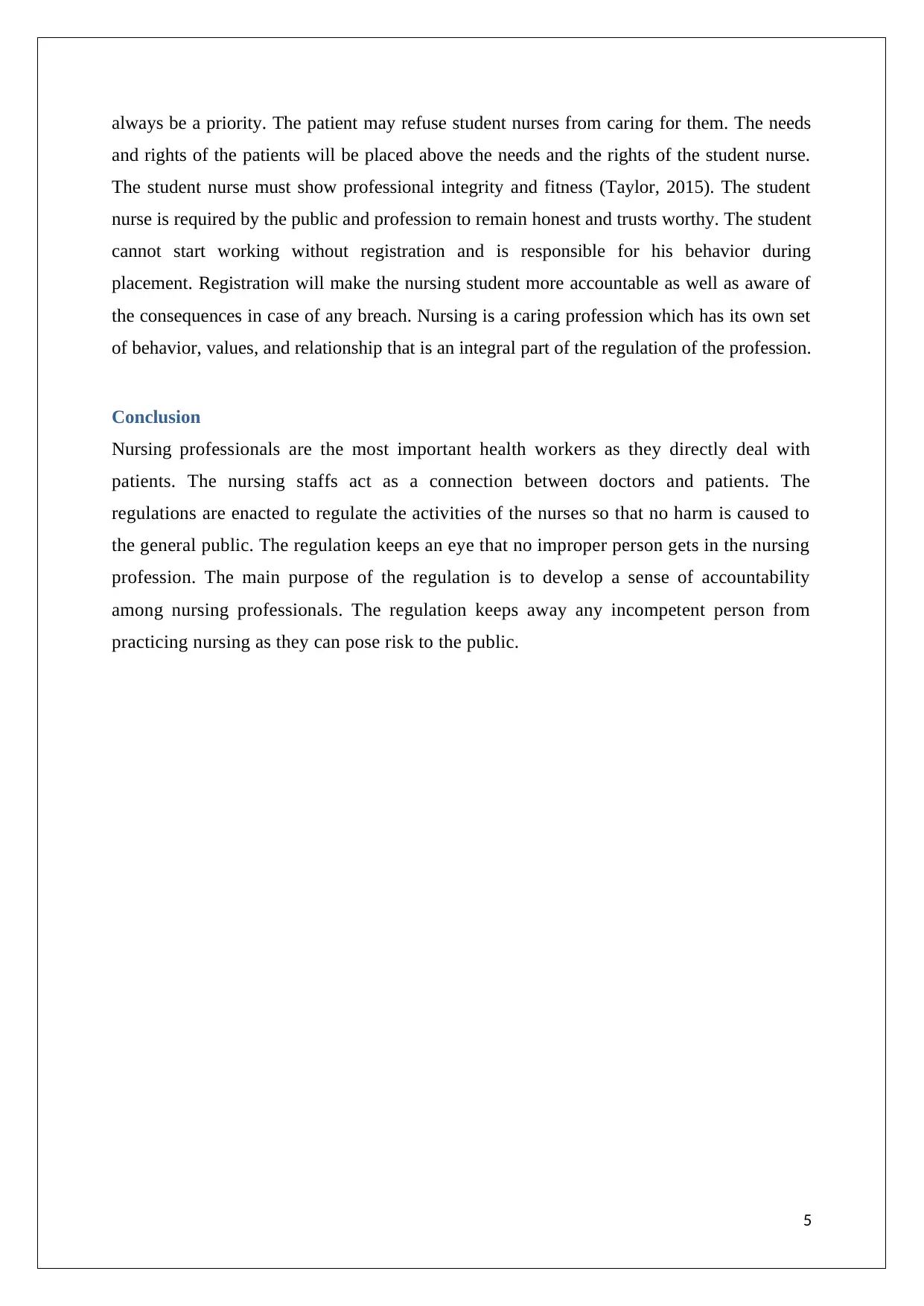
always be a priority. The patient may refuse student nurses from caring for them. The needs
and rights of the patients will be placed above the needs and the rights of the student nurse.
The student nurse must show professional integrity and fitness (Taylor, 2015). The student
nurse is required by the public and profession to remain honest and trusts worthy. The student
cannot start working without registration and is responsible for his behavior during
placement. Registration will make the nursing student more accountable as well as aware of
the consequences in case of any breach. Nursing is a caring profession which has its own set
of behavior, values, and relationship that is an integral part of the regulation of the profession.
Conclusion
Nursing professionals are the most important health workers as they directly deal with
patients. The nursing staffs act as a connection between doctors and patients. The
regulations are enacted to regulate the activities of the nurses so that no harm is caused to
the general public. The regulation keeps an eye that no improper person gets in the nursing
profession. The main purpose of the regulation is to develop a sense of accountability
among nursing professionals. The regulation keeps away any incompetent person from
practicing nursing as they can pose risk to the public.
5
and rights of the patients will be placed above the needs and the rights of the student nurse.
The student nurse must show professional integrity and fitness (Taylor, 2015). The student
nurse is required by the public and profession to remain honest and trusts worthy. The student
cannot start working without registration and is responsible for his behavior during
placement. Registration will make the nursing student more accountable as well as aware of
the consequences in case of any breach. Nursing is a caring profession which has its own set
of behavior, values, and relationship that is an integral part of the regulation of the profession.
Conclusion
Nursing professionals are the most important health workers as they directly deal with
patients. The nursing staffs act as a connection between doctors and patients. The
regulations are enacted to regulate the activities of the nurses so that no harm is caused to
the general public. The regulation keeps an eye that no improper person gets in the nursing
profession. The main purpose of the regulation is to develop a sense of accountability
among nursing professionals. The regulation keeps away any incompetent person from
practicing nursing as they can pose risk to the public.
5
⊘ This is a preview!⊘
Do you want full access?
Subscribe today to unlock all pages.

Trusted by 1+ million students worldwide
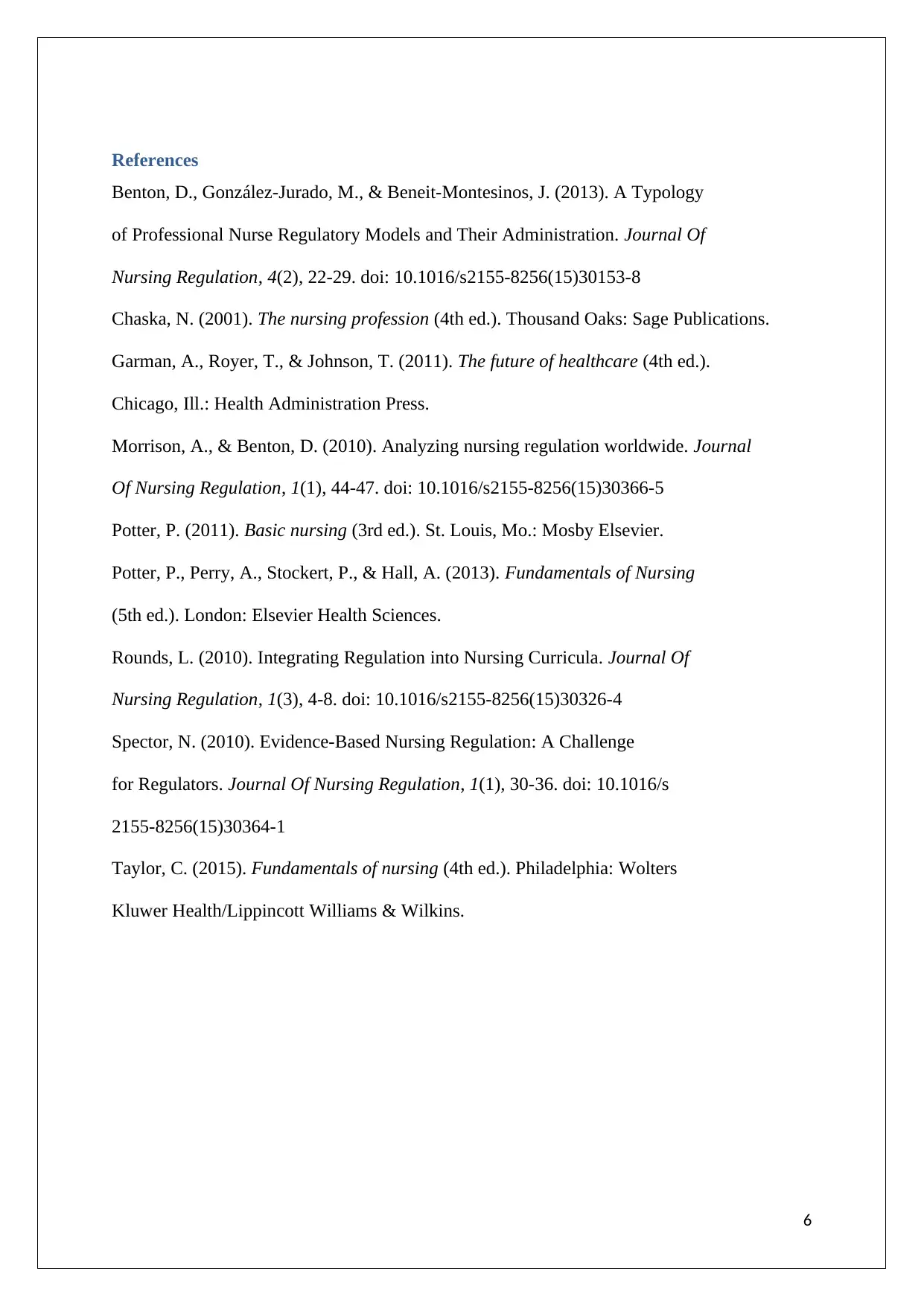
References
Benton, D., González-Jurado, M., & Beneit-Montesinos, J. (2013). A Typology
of Professional Nurse Regulatory Models and Their Administration. Journal Of
Nursing Regulation, 4(2), 22-29. doi: 10.1016/s2155-8256(15)30153-8
Chaska, N. (2001). The nursing profession (4th ed.). Thousand Oaks: Sage Publications.
Garman, A., Royer, T., & Johnson, T. (2011). The future of healthcare (4th ed.).
Chicago, Ill.: Health Administration Press.
Morrison, A., & Benton, D. (2010). Analyzing nursing regulation worldwide. Journal
Of Nursing Regulation, 1(1), 44-47. doi: 10.1016/s2155-8256(15)30366-5
Potter, P. (2011). Basic nursing (3rd ed.). St. Louis, Mo.: Mosby Elsevier.
Potter, P., Perry, A., Stockert, P., & Hall, A. (2013). Fundamentals of Nursing
(5th ed.). London: Elsevier Health Sciences.
Rounds, L. (2010). Integrating Regulation into Nursing Curricula. Journal Of
Nursing Regulation, 1(3), 4-8. doi: 10.1016/s2155-8256(15)30326-4
Spector, N. (2010). Evidence-Based Nursing Regulation: A Challenge
for Regulators. Journal Of Nursing Regulation, 1(1), 30-36. doi: 10.1016/s
2155-8256(15)30364-1
Taylor, C. (2015). Fundamentals of nursing (4th ed.). Philadelphia: Wolters
Kluwer Health/Lippincott Williams & Wilkins.
6
Benton, D., González-Jurado, M., & Beneit-Montesinos, J. (2013). A Typology
of Professional Nurse Regulatory Models and Their Administration. Journal Of
Nursing Regulation, 4(2), 22-29. doi: 10.1016/s2155-8256(15)30153-8
Chaska, N. (2001). The nursing profession (4th ed.). Thousand Oaks: Sage Publications.
Garman, A., Royer, T., & Johnson, T. (2011). The future of healthcare (4th ed.).
Chicago, Ill.: Health Administration Press.
Morrison, A., & Benton, D. (2010). Analyzing nursing regulation worldwide. Journal
Of Nursing Regulation, 1(1), 44-47. doi: 10.1016/s2155-8256(15)30366-5
Potter, P. (2011). Basic nursing (3rd ed.). St. Louis, Mo.: Mosby Elsevier.
Potter, P., Perry, A., Stockert, P., & Hall, A. (2013). Fundamentals of Nursing
(5th ed.). London: Elsevier Health Sciences.
Rounds, L. (2010). Integrating Regulation into Nursing Curricula. Journal Of
Nursing Regulation, 1(3), 4-8. doi: 10.1016/s2155-8256(15)30326-4
Spector, N. (2010). Evidence-Based Nursing Regulation: A Challenge
for Regulators. Journal Of Nursing Regulation, 1(1), 30-36. doi: 10.1016/s
2155-8256(15)30364-1
Taylor, C. (2015). Fundamentals of nursing (4th ed.). Philadelphia: Wolters
Kluwer Health/Lippincott Williams & Wilkins.
6
1 out of 7
Related Documents
Your All-in-One AI-Powered Toolkit for Academic Success.
+13062052269
info@desklib.com
Available 24*7 on WhatsApp / Email
![[object Object]](/_next/static/media/star-bottom.7253800d.svg)
Unlock your academic potential
Copyright © 2020–2025 A2Z Services. All Rights Reserved. Developed and managed by ZUCOL.





